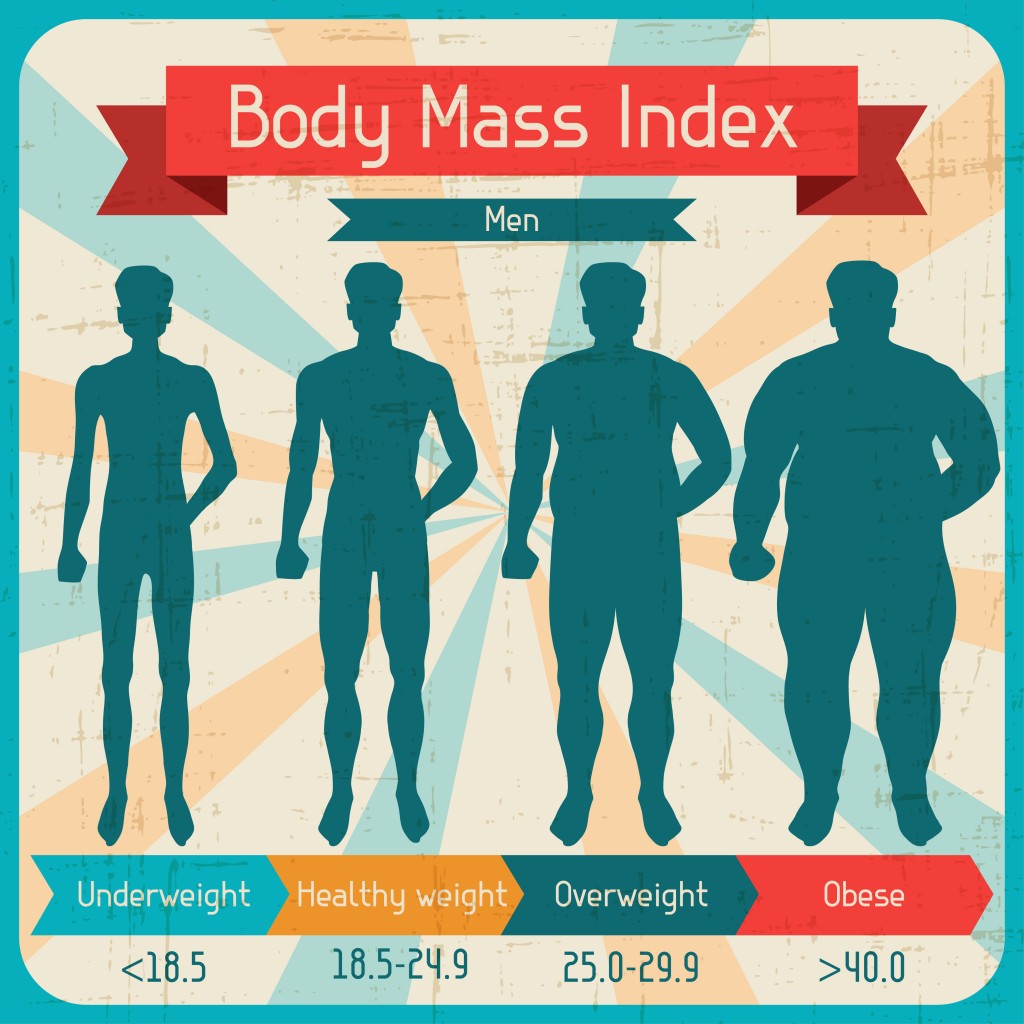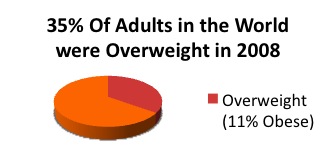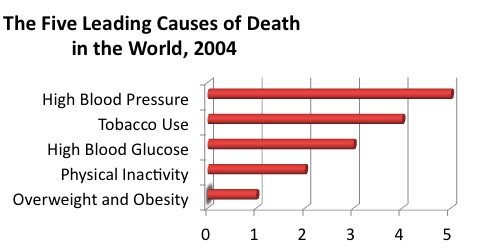What’s the Difference Between Obesity and Being Overweight?
Overweight and Obesity can be Calculated Using BMI
According to WIN (Weight Control Information Network), being overweight is defined as an excess amount of body weight from muscle, bone, fat or water. Obesity is defined as an excess amount of body fat. BMI (body mass index) is used to numerically define whether a person is normal weight, overweight or obese. To calculate BMI, weight is taken in kilograms and then divided by height, which is taken in squared meters. Round this number to the nearest decimal point.
The results are interpreted as follows for adults (20 years old and above):
- less than 18.5 = underweight
- 18.5 – 24.9 = normal weight
- 25 – 29.9 = overweight
- 30 + = obesity
- 40 + = extreme obesity
The BMI for kids and teens ages 2-19 years old is calculated differently. In the US growth charts compiled by the Centers for Disease Control are referenced. If kids fall at or above the 85% range but below 95% for children of same sex and age, then they are considered overweight. If kids fall at or above the 95% range for children of the same age and sex, then they are obese. If you are concerned that your child may be overweight or obese, reference the BMI percentile calculator for children and teens on the Center for Disease Control website.
Incidence of Obesity
There is a Significant Increase of Obesity in Both Children and Adults Today
The 2009/2010 National Health and Nutrition Examination survey revealed the following statistics:
- More than 2 in 3 adults are overweight or obese
- More than 1 in 3 adults are obese
- More than 1 in 20 adults have extreme obesity
- More than 1 in 6 kids and adolescents (age 6-19) are obese. According to the CDC, obese children are more likely to become obese adults
Obesity Increases the Risk for Many Illnesses
Being overweight or obese adds extra stress on the body and increases risk for type 2 diabetes, high blood pressure, heart disease, non alcoholic fatty liver disease, osteoarthritis, stroke, sleep apnea, and/or cancer-especially breast, colon, endometrial and kidney.
Detox
for Weight Loss
AUGUST 1 – 11, 2019
China’s “obesity explosion” has resulted in growth of Chinese fat camps, which costs about $1,000 (U.S. dollars) per child.
Source: National Geographic News “Obesity Explosion May Weigh on China’s Future” August 8, 2006
Wordwide obesity has nearly doubled since 1980
Overweight and Obesity – The Fifth Leading Cause of Death in the World

The prevalence of obesity and overweight in the world: the percentage of the population that is overweight and obese
What Causes Today’s High Prevalence of Obesity?
There are a wide variety of reasons for weight gain. These include:
- Foods consumed
- Eating behaviors
- Energy expenditure lower than calories consumed
- Hormonal imbalance
- Toxic exposures
- Lack of physical exercise
- Side effects of prescription drugs
- Insomnia
- Mental/emotional factors
Foods Consumed
High Fructose Corn Syrup (HFCS)
HFCS is a man made sugar from corn that is rapidly absorbed in the bloodstream and causes a sudden rise in insulin, weight gain, and eventually results in diabetes.
HFCS is used to improve taste in foods and is also used as a preservative. The average American consumption was 39 pounds in 1980, and in 2001 it peaked to 62.6 lbs. The use has decreased, thanks to several corporations (Starbucks, Ocean Spray Cranberry) removing it from their products! HFCS can be found in drinks such as sodas and diet sodas, juices, and beer. It is also in many different processed foods such as protein bars, candy, processed fruits, canned foods, crackers, breads, cereals and cakes. It can be found in condiments such as ketchup, sauces, dressings, and mayonnaise. It is a popular ingredient used in all fast food restaurants. It will not be found in any product labeled organic but can be in “natural” products. Princeton University conducted a study on rats in 2010. They found that rats fed HFCS gained a significant amount of weight versus the rats fed table sugar. These rats also had an abnormal increase in body fat, especially around the abdomen. They also had an increase in circulating triglycerides in the blood. They compared these results with a study done feeding rats a high fat diet. Not all of these rats gained weight like they did in the HFCS study.
HISTORY OF HIGH FRUCTOSE CORN SYRUP
High fructose corn syrup (HFCS) is a man-made product that was created in the 1960’s and has been used extensively since the late 1970’s due to the rising costs of sugar. Corn crops in the US are subsidized by our government. HFCS is 75% sweeter than sugar and far less expensive. NBC news reported on HFCS and found it to contain small amounts of mercury in their samples. This comes from the caustic soda that is used to separate the corn starch from the kernel.
Today, much of the US technology uses mercury free caustic soda but this is not true for manufacturers worldwide. Dr. Mark Hyman has done extensive research on HFCS in 2011. He simplifies the chemistry behind HFCS: Sugar or sucrose is made from glucose and fructose bonded together. Our digestive enzymes break the bond releasing these two molecules. HFCS does not require digestion because there is no bond to break. It is rapidly absorbed into the bloodstream. The rapidly absorbed glucose causes a rise in insulin, which is the body’s fat storage hormone, increasing weight gain, and eventually resulting in diabetes. It also increases the amount of circulating triglycerides, which can create metabolic syndrome. Nutritional scientist, Dr Arnes’ research shows that HFCS can cause leaky gut syndrome by destroying the integrity of the cell membranes and triggering body-wide inflammation, which is the basis for many chronic diseases.
Hydrogenated Oils
Trans-fatty acids or partially hydrogenated oils are artificially produced by adding a hydrogen molecule to a liquid vegetable oil in order to make it into a solid fat. This makes it easy to use, increases shelf life, is inexpensive and also gives it a desirable taste and texture. This oil can then be used multiple times to deep fry in. According to the American Heart Association, hydrogenated oils will increase your LDL (bad cholesterol) and decrease your HDL (good cholesterol), causing plaque build-up on the artery walls. It is found in 40% of the products on supermarket shelves. It can be found in fried foods, baked goods, margarines and shortening.
Soda Consumption
Research has shown that weight gain is linked to DIET soda consumption. According to the University of Texas Health Science Center 1984 study, each daily can of diet soda that a person drinks will increase their risk of obesity by 41%. Numerous studies show that Aspartame (artificial sweetener used in diet soda) has been found to cause weight gain and diabetes by increasing insulin resistance. Aspartame raises insulin levels as much as sugar does. ( link to DM article) Sugary drinks also dull the taste buds and lead to an increased craving for sweet foods. According to ABC news, 80% of our public schools have contracts with Coke or Pepsi. This began in the 1990’s as a way for the school districts to acquire needed money. They sold exclusive pouring rights to one or the other soda company. This would then be the only product they would sell in the vending machines, snack bars, stores and sporting events. For example, an Illinois school signed a 10 year contract with Coca cola who agreed to pay 4 million dollars up front and then an additional $350,000 per year to sell their beverages in the schools. (Read article – Truth about drinking Coke and Pepsi).
Alcohol
Alcohol consumption contributes to weight gain in several ways. It is turned into acetate (vinegar) in the body, which slows down metabolism, resulting in less fat burned. Alcohol also stimulates the secretion of ghrelin, the hunger hormone secreted by the stomach that arouses appetite when it binds to the hypothalamus, the brain hunger center. Alcohol lowers testosterone levels while increasing cortisol, which results in abdominal fat and loss of muscle mass.
Food Additives
Growth Hormones
Growth hormones are given to cattle to make them gain weight faster and increase their milk production. According to Organic Valley, the FDA approved 20 hormones that can be used in livestock production. In 1989 the European Union banned all hormone use in beef production. Studies have been done to see if growth hormones fed to cattle will cause weight gain in humans. The results have been inconclusive.
Chemicals and Toxins in Foods
There are 14,000 man-made chemicals added in our American food supply. These include chemicals for artificial coloring, flavor enhancers, preservatives, caffeine, olestra, antibiotics, growth hormones, pesticides and insecticides, phthalates (plastics), highly processed forms of protein, chemical forms of B vitamins, and GMO’s (genetically modified food).
Doctor Mark Hyman claims that environmental toxins can make weight loss harder to achieve. They do this by disrupting the body’s metabolic pathways and causing them to work less efficiently. The CDC reported that everyone has stores of chemicals accumulated in their body fat. The average newborn has 287 chemicals in their umbilical cord blood, 217 are neurotoxins. Several studies have shown that PCB’s (polychlorinated biphenols) increase the risk of diabetes.
There are Junk food and fast foods that have been chemically manipulated to be stimulating and create the desire to eat more. Some of the more common chemicals include; MSG (monosodium glutamate) a flavor enhancer that is linked to an increased risk of being overweight. It is also an excitotoxin. An excitotoxin is a chemical that causes a brain cell to become overexcited and fire uncontrollably, leading to cell death. Many toxic synthetic chemicals that we consume are fat soluble and stored in our body fat as our body is unable to eliminate them. Carbamate, a commonly used insecticide found in commercial produce, has been found to slow down metabolism.
What causes today’s high prevalence of obesity?
There are a wide variety of reasons for weight gain. These include:
- Foods consumed
- Eating behaviors
- Energy Expenditure lower than Calories Consumed
- Hormonal imbalance
- Toxic exposures
- Lack of physical exercise
- Side effects of prescription drugs
- Insomnia
- Mental/emotional factors
Eating Behaviors
The Role of Dopamine and Serotonin in Eating Behavior: Hunger and Satiety
Appetite is the result of increased dopamine secretion by the hypothalamus, the pleasure center of the brain, in response to higher levels of ghrelin, the hunger hormone secreted by the stomach when blood sugar is low. When the body has had enough, serotonin is released, halting the secretion of dopamine. Low levels of serotonin or a low number of receptors can obliterate this process and lead to overeating and weight gain.
Overeating and Food Addiction
There is a normal satiety reflex that signals when to finish eating. This normal reflex can be bypassed by the brain and overeating becomes possible because there is a natural pleasure in eating. Some individuals can use food as a drug, to extend this pleasure and get into the same abusive behavior as any drug addict. This addictive behavior is encouraged by stimulating and concentrated foods such as, sugar, carbohydrates, salt and fats. Repeated overeating distends the stomach requiring more food to activate the receptors in the stomach that signal the brain that the body has had enough food.
Cooked foods do not need much chewing and do not require much time to eat. This short eating time decreases the satisfaction from eating and also postpones the satiety reflex.
Boredom leads to unconscious eating.
Convenience and affordability of fast and junk foods encourages overeating.
Mindless eating occurs while driving, walking, watching TV. This constant eating does not allow our digestive system to rest. It also uses up all of our enzyme reserves which creates a condition favorable for chronic illness.
Emotional eating: Lack of other pleasurable activities such as sex, exercise or creative outlets, can lead to emotional eating. Inability to deal with negative feelings such as loneliness, anger or sadness can be transferred to overconsumption of food.
Mental/Emotional Factors
According to the 2009 Harvard Mental Health Letter, people console themselves with comfort foods that are high in fat, sugar and calories, when they are feeling anxious, lonely, and angry or suffering from low self esteem. Overweight people tend to feel unattractive and suffer discrimination, keeping them from socializing.
Snacking
Snacking stimulates insulin and when insulin is produced the body will store fat.
Food Sensitivities
Hidden food sensitivities can cause weight gain, inflammation and a weakened immune system. Dairy and gluten are the most common food sensitivities. Celiac disease is caused by intolerance to gluten and the immune system attacks the gut lining resulting in inflammation and leaky gut.
Hormonal Imbalance
High or Low Leptin – the Obesity Hormone
Leptin is a hormone that is secreted by our fat cells when fat storage is completed after a meal. Leptin stimulates serotonin and inhibition of dopamine secretion, producing the feeling of satiety. In a study using mice, the ones injected with leptin ate less food and lost weight. Fasting and low calorie diets can produce low levels of leptin, making it more difficult to feel satisfied after eating. The Arcuate nucleus in the hypothalamus of the brain, controls metabolic rate, hunger and satiety. It contains two types of cells: one for hunger and one for satiety. Ghrelin is a hormone produced by the stomach and travels to the brain to turn on hunger cells and turn off satiety. Leptin, on the other hand, turns on satiety and turns off hunger. In obesity, there are more fat cells and the body eventually becomes insensitive to Leptin. Fat cells produce the hormone but the body will no longer respond to it. Satiety is lost. The body then becomes hypersensitive to ghrelin, increasing the sensation of hunger.
Low Thyroid, High Cortisol and Low Melatonin
Hypothyroidism needs to be ruled out. If thyroid hormone is low, the body will not be able to burn stored fat. Hypothyroidism also causes a slower metabolism.
Cortisol’s function is to increase blood sugar for quick energy usage. Continuous cortisol produced by the adrenal glands during stress, (physical, mental or emotional) triggers the release of insulin which begins to store fat. Washington School of Medicine has found a link between low melatonin levels and weight gain caused by increased cortisol levels.
Lack of Sleep Insomnia
Sleep deprivation is associated with hormonal imbalance: High cortisol, low melatonin, low leptin and elevated levels of excitatory neurotransmitters. According to WebMD, the average person should get a minimum of 7.5 hours of sleep per night. Read more about insomnia.
Lack of Physical Exercise/Sedentary Lifestyle
In a sedentary lifestyle more calories are consumed than used and these excess calories are stored as fat. A sedentary lifestyle decreases production of serotonin from which melatonin, the sleep hormone, is made. Our children are the fist victims of our poor appreciation for exercise. Early lack of physical activity is even worse for children because it sets up poor lifelong habits that are then harder to break. ABC news did a special report on schools cutting PE/gym classes to save money that could instead be used for math and reading programs. The CDC claims that over 60% of kids age 6-13, do not participate in any organized physical activity outside of school, and 23% of kids do not engage in any physical activity at all in their free time. The California Dept of Education correlates higher academic achievement with higher levels of fitness.
Prescription Drugs
Many prescription drugs cause weight gain. This can be from increased appetite, fluid retention, fatigue, or decreased activity level. Some of the common drugs associated with weight gain are antidepressants, high blood pressure and anti- seizure medications, birth control pills, and corticosteroids.
Lifestyle Changes in Naturopathic Medicine
Contemporary physical and mental illness both need to be addressed on the physical, mental, emotional, spiritual and social levels to be treated successfully on a permanent basis. Nutrition and exercise can restore the biochemistry of the body and the brain and a psycho-spiritual approach is necessary for behavioral changes to happen. Dr. Baylac reviews the need of psychology in physical medicine for successful lifestyle changes and the need of nutrition in psychiatry to resolve mental illness. The following presentation focuses on how mind, body and spirit approaches work together to bring about permanent lifestyle changes. The specific conditions in which this is demonstrated in her talk are: food addiction (obesity, overweight) and depression.
Treatment of Overweight and Obesity
Conventional Treatments
Conventional treatments include surgery, diets, and pills. Many result in serious side effects and relapses.
Surgery
- Lap Band surgery – an adjustable, inflatable, silicon ring is surgically placed on the top part of the stomach decreasing the amount of food that it can hold. This surgery costs about 12-20 thousand dollars.
- Gastric Bypass surgery – this procedure is more invasive. This involves cutting or stapling the stomach or intestinal re-routing. This can cost between 20-30 thousand dollars.
- Side effects from these surgeries may include urinary and fecal incontinence. 20% of people who have these surgeries may have complications such as malnutrition, anemia or osteoporosis.
- Liposuction – this is a surgical procedure that improves the body contour by removing excess fat deposits between the skin and muscle. A small steel tube is inserted into small incisions in the skin. Suction then creates tiny tunnels in the fatty layers that will eventually collapse later after the surgery. Some of the prices include $2400 for hips, $1800 for buttocks, $3,000 for outer thighs, $2,000 for chin, cheeks, neck, $1,500 arms, with an additional non surgical fee of $1,600
Diet Pills
1996’s notorious drug Fen-phen caused fatal heart problems and was removed from the market in September of 1997.
Fad Diets and Weight Loss Programs
The list is endless!
Jenny Craig, Weight Watchers, Atkins diet, South Beach diet, The Zone diet, Sonoma diet, Mediterranean diet, the Biggest Loser Club, Medifast, diet.com, e-diets, dietwatch.com, Julian Michaels-The Biggest Loser fitness trainer and life coach, Denise Austin, Mayo Clinic diet book.
A UCLA study shows that 41% of people who go on diets will gain back lost weight within the year. Other studies show that 90% will regain the weight over a longer period of time. Studies on binge eating and overeating disorders shows that restriction caused by calorie counting has a pendulum effect on the brain and causes excess in the other direction. Spending time with family and friends, working long hours, busy schedules, and eating out, all affect the food choices we make.
Detox for Weight Loss & Lifestyle Changes To Keep It Off
HAWAII LIFESTYLE CHANGE SPECIALISTS & RAW DETOXIFICATION CENTER
Holistic Natural Residential Weight Loss Programs for long-term weight loss consisting of improving eating, sleeping and exercise habits with regular schedules, addressing the underlying emotional issues, such as self-esteem, loneliness and boredom, restoring the natural hormonal hunger satiety cycle, and educating patients about shopping and food preparation. Our weight loss programs Hawaii focus on detoxification and not on dietary restriction. We use a raw food detox diet and natural detox procedures such as infrared sauna, coffee enema, exercise, along with lifestyle counseling and psychotherapy. We remove heavy metals and chemicals from fat storage and consequently weight loss ensures.










